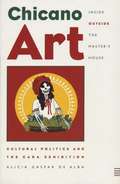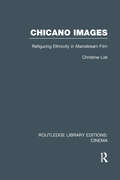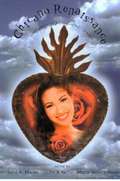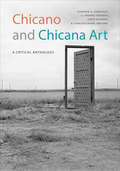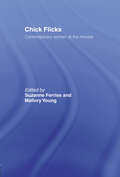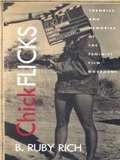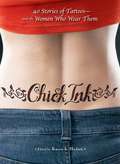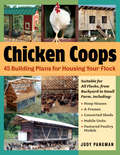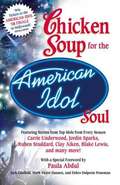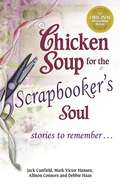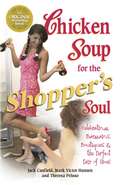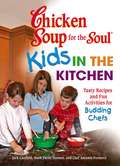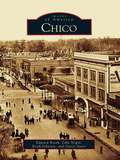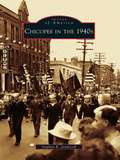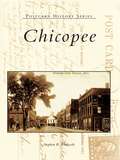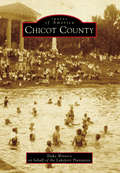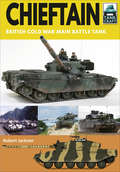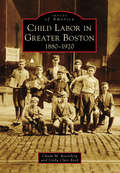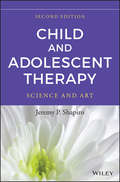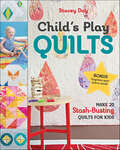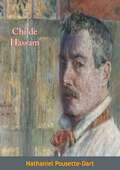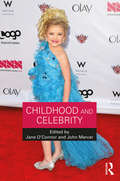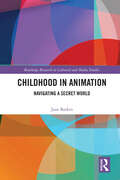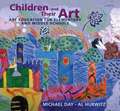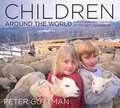- Table View
- List View
Chicano Art Inside/Outside The Master's House: Cultural Politics and the CARA Exhibition
by Alicia Gaspar De AlbaIn the early 1990s, a major exhibition-Chicano Art: Resistance and Affirmation, 1965-1985-toured major museums around the United States. As a first attempt to define and represent Chicano/a art for a national audience, the exhibit attracted both praise and controversy, while raising fundamental questions about the nature of multiculturalism in the U. S. This book presents the first interdisciplinary cultural study of the CARA exhibit. Alicia Gaspar de Alba looks at the exhibit as a cultural text in which the Chicano/a community affirmed itself not as a "subculture" within the U. S. but as an "alter-Native" culture in opposition to the exclusionary and homogenizing practices of mainstream institutions. She also shows how the exhibit reflected the cultural and sexual politics of the Chicano Movement and how it serves as a model of Chicano/a popular culture more generally. Drawing insights from cultural studies, feminist theory, anthropology, and semiotics, this book constitutes a wide-ranging analysis of Chicano/a art, popular culture, and mainstream cultural politics. It will appeal to a diverse audience in all of these fields.
Chicano Images: Refiguring Ethnicity in Mainstream Film (Routledge Library Editions: Cinema)
by Christine ListProviding textual analysis of 12 feature films written and directed by filmmakers who explore aspects of the Chicano cultural movement, this book discusses films including Cheech and Chong's Still Smokin' (1983), El Norte (1985), and Break of Dawn (1988). The text analyzes the portrayal of Chicano, or Mexican American, identity in films by chicanos. Part historiography, part film analysis, part ethnography, this book offers a compelling story of how Chicanos challenge, subvert and create their own popular portrayals of Chicanismo. Historical stereotypical images in Hollywood films are discussed alongside contemporary images portrayed by Hollywood studios and independent Chicano filmmakers. The author examines the way in which newer films "construct new representations of Chicano culture" and present a greater variety of images of Chicanos for mainstream audiences. Originally published in 1996, this authoritative volume provides a full history of the Chicano cultural movement beginning in the 1960s as well as information on the development of Mexican American film production.
Chicano Renaissance: Contemporary Cultural Trends
by David R. Maciel Isidro D. Ortiz María Herrera-SobekAmong the lasting legacies of the Chicano Movement is the cultural flowering that it inspired--one that has steadily grown from the 1960s to the present. It encompassed all of the arts and continues to earn acclaim both nationally and internationally. Although this Chicano artistic renaissance received extensive scholarly attention in its initial phase, the post-Movimiento years after the late 1970s have been largely overlooked. This book meets that need, demonstrating that, despite the changes that have taken place in all areas of Chicana/o arts, a commitment to community revitalization continues to underlie artistic expression. This collection examines changes across a broad range of cultural forms--art, literature, music, cinema and television, radio, and theater--with an emphasis on the last two decades. Original articles by both established and emerging scholars review such subjects as the growth of Tejano music and the rise of Selena, how films and television have affected the Chicana/o experience, the evolution of Chicana/o art over the last twenty years, and postmodern literary trends. In all of the essays, the contributors emphasize that, contrary to the popular notion that Chicanas/os have succumbed to a victim mentality, they continue to actively struggle to shape the conditions of their lives and to influence the direction of American society through their arts and social struggle. Despite decades usually associated with self-interest in the larger society, the spirit of commitment and empowerment has continued to infuse Chicana/o cultural expression and points toward a vibrant future. CONTENTS All Over the Map: La Onda Tejana and the Making of Selena, Roberto R. Calderón Outside Inside-The Immigrant Workers: Creating Popular Myths, Cultural Expressions, and Personal Politics in Borderlands Southern California, Juan Gómez-Quiñones "Yo soy chicano": The Turbulent and Heroic Life of Chicanas/os in Cinema and Television, David R. Maciel and Susan Racho The Politics of Chicano Representation in the Media, Virginia Escalante Chicana/o and Latina/o Gazing: Audiences of the Mass Media, Diana I. Ríos An Historical Overview/Update on the State of Chicano Art, George Vargas Contemporary Chicano Theater, Arturo Ramírez Breaking the Silence: Developments in the Publication and Politics of Chicana Creative Writing, 1973-1998, Edwina Barvosa-Carter Trends and Themes in Chicana/o Writings in Postmodern Times, Francisco A. Lomelí, Teresa Márquez, and María Herrera-Sobek
Chicano and Chicana Art: A Critical Anthology
by Jennifer A. González C. Ondine Chavoya Chon Noriega Terezita RomoThis anthology provides an overview of the history and theory of Chicano/a art from the 1960s to the present, emphasizing the debates and vocabularies that have played key roles in its conceptualization. In Chicano and Chicana Art—which includes many of Chicano/a art's landmark and foundational texts and manifestos—artists, curators, and cultural critics trace the development of Chicano/a art from its early role in the Chicano civil rights movement to its mainstream acceptance in American art institutions. <P><P>Throughout this teaching-oriented volume they address a number of themes, including the politics of border life, public art practices such as posters and murals, and feminist and queer artists' figurations of Chicano/a bodies. They also chart the multiple cultural and artistic influences—from American graffiti and Mexican pre-Columbian spirituality to pop art and modernism—that have informed Chicano/a art's practice. <P><P>Contributors. Carlos Almaraz, David Avalos, Judith F. Baca, Raye Bemis, Jo-Anne Berelowitz, Elizabeth Blair, Chaz Bojóroquez, Philip Brookman, Mel Casas, C. Ondine Chavoya, Karen Mary Davalos, Rupert García, Alicia Gaspar de Alba, Shifra Goldman, Jennifer A. González, Rita Gonzalez, Robb Hernández, Juan Felipe Herrera, Louis Hock, Nancy L. Kelker, Philip Kennicott, Josh Kun, Asta Kuusinen, Gilberto “Magu” Luján, Amelia Malagamba-Ansotegui, Amalia Mesa-Bains, Dylan Miner, Malaquias Montoya, Judithe Hernández de Neikrug, Chon Noriega, Joseph Palis, Laura Elisa Pérez, Peter Plagens, Catherine Ramírez, Matthew Reilly, James Rojas, Terezita Romo, Ralph Rugoff, Lezlie Salkowitz-Montoya, Marcos Sanchez-Tranquilino, Cylena Simonds, Elizabeth Sisco, John Tagg, Roberto Tejada, Rubén Trejo, Gabriela Valdivia, Tomás Ybarra-Frausto, Victor Zamudio-Taylor
Chick Flicks: Contemporary Women at the Movies
by Mallory Young Suzanne FerrissFrom An Affair to Remember to Legally Blonde, "chick flicks" have long been both championed and vilified by women and men, scholars and popular audiences. Like other forms of "chick culture," which the editors define as a group of mostly American and British popular culture media forms focused primarily on twenty- to thirtysomething, middle-class—and frequently college-educated—women, chick flicks have been accused of reinscribing traditional attitudes and reactionary roles for women. On the other hand, they have been embraced as pleasurable and potentially liberating entertainments, assisting women in negotiating the challenges of contemporary life. A companion to the successful anthology Chick Lit: The New Woman’s Fiction, this edited volume consists of 11 original essays, prefaced by an introduction situating chick flicks within the larger context of chick culture as well as women’s cinema. The essays consider chick flicks from a variety of angles, touching on issues of film history, female sexuality (heterosexual and homosexual), femininity, female friendship, age, race, ethnicity, class, consumerism, spectatorship, pleasure and gender definition. An afterword by feminist film theorist Karen Hollinger considers the chick flick’s transformation from the woman’s films of the ’40s to the friendship films of the ’80s and those of the "return to the classics" trend of the ’90s, while highlighting the value of the volume’s contributions to contemporary debates and sketching possibilities for further study.
Chick Flicks: Theories and Memories of the Feminist Film Movement
by B. Ruby RichIf there was a moment during the sixties, seventies, or eighties that changed the history of the women's film movement, B. Ruby Rich was there. Part journalistic chronicle, part memoir, and 100% pure cultural historical odyssey, Chick Flicks--with its definitive, the-way-it-was collection of essays--captures the birth and growth of feminist film as no other book has done.For over three decades Rich has been one of the most important voices in feminist film criticism. Her presence at film festivals (such as Sundance, where she is a member of the selection committee), her film reviews in the Village Voice, Elle, Out, and the Advocate, and her commentaries on the public radio program "The World" have secured her a place as a central figure in the remarkable history of what she deems "cinefeminism." In the hope that a new generation of feminist film culture might be revitalized by reclaiming its own history, Rich introduces each essay with an autobiographical prologue that describes the intellectual, political, and personal moments from which the work arose. Travel, softball, sex, and voodoo all somehow fit into a book that includes classic Rich articles covering such topics as the antiporn movement, the films of Yvonne Rainer, a Julie Christie visit to Washington, and the historically evocative film Maedchen in Uniform. The result is a volume that traces the development not only of women's involvement in cinema but of one of its key players as well.The first book-length work from Rich--whose stature and influence in the world of film criticism and theory continue to grow--Chick Flicks exposes unexplored routes and forgotten byways of a past that's recent enough to be remembered and far away enough to be memorable.
Chick Ink
by Karen L. HudsonJoin the women of Chick Ink in this celebration of the tattoos that grace our bodies, tell our stories, and mark forever the significant moments of our lives. Because if you're a woman with a tattoo, you're woman enough for anything.
Chicken Coops: 45 Building Ideas for Housing Your Flock
by Judy PangmanJust like houses, chicken coops come in all shapes and sizes. Judy Pangman presents how-to drawings and conceptual plans for 45 coops — from the strictly practical to flights of fancy — guaranteed to meet the needs of every bird owner, however big or small your flock may be. Color photographs and innovative suggestions fill this encouraging guide, while lively anecdotes profile an array of coop builders and their various construction methods. Start building the coop of your chickens’ dreams!
Chicken Soup for the American Idol Soul
by Jack Canfield Mark Victor Hansen Debra PonemanThose closest to the heart of American Idol - from the executive producers to the stylists, from the fans to the judges share their moving stories of obstacles overcome, love and changed forever.
Chicken Soup for the Scrapbooker's Soul
by Jack Canfield Mark Victor Hansen Allison Connors Debbie HaasFor anyone who appreciates the value of memories found in a photo Afternoons spent creating pages of recent and distant memories. Clipping colorful images and adding stickers to adorn your favorite photos and letters while capturing a friendship in pictures surrounded by ribbons and various textures. Scrapbooking is a labor of love for the millions who spend their spare time engrossed in new layouts and inspired ideas. For some it is a hobby that turned into their life's passion, while others see it as a way to uniquely record family history for generations to come. Chicken Soup for the Scrapbooker's Soul will inspire you or your favorite scrapbooker by offering a glimpse into the lives of these creatively gifted, generous souls who have found lasting friendships, rekindled love, and helped those in need through the heartfelt gift of a scrapbook.Reminisce with scrapbookers about the deep relationships they formed creating pages and teaching the art to their children, how siblings bonded over a Saturday afternoon spent with scissors and glue, and how some stay-at-home moms turned their creative outlets into lucrative scrapbooking careers. Chicken Soup for the Scrapbooker's Soul is for the millions of scrapbookers already out there, and for those who aspire to crop, journal, and embellish their cherished photos and memories.
Chicken Soup for the Shopper's Soul
by Jack Canfield Mark Victor Hansen Theresa PelusoShopaholics Unite!You know it when you find it: the perfect black dress, the welcome mat for your first home, the yellow bunny sheets for your best friend's baby shower, the laundry basket your nephew will never use in college. Whatever the mission, shopping for yourself and others marks life's milestones, celebrates your passions and expresses your individuality. And most important, shopping is just plain fun!Whether your preferred stomping ground is an antique shop or a mega mall, a bargain basement or a boutique, a flea market or Fifth Avenue, you'll be thoroughly entertained, inspired and validated by the true-life shopping adventures of like-minded people like you--people who freely admit they were Born to Shop--and who never cease to find fulfillment, enjoyment and a few great buys while doing it.
Chicken Soup for the Soul Kids in the Kitchen
by Jack Canfield Mark Victor Hansen Antonio FronteraFamilies that cook together stay together! Chef Antonio knows about family fun in the kitchen. He grew up with family members who cooked, ate, and spent most of their time whipping up delicious dishes together. He fell in love with cooking during those formative years and grew up to become a fabulous chef and a five-star restaurant owner. Now, Chef Antonio shares his favorite family recipes with you and your family in Chicken Soup for the Soul Kids in the Kitchen. He reveals the secret ingredient in Grandpa Joe's Jelly Cookies, inspires budding chefs with Spaghetti Pie, and entices the kid in every adult with Homemade Marshmallows. This unique Chicken Soup for the Soul cookbook is filled with mouthwatering recipes that will have even the youngest family members clamoring to help. Packed inside are kid-friendly recipes, safety and cleanup tips, food-related activities, and charming stories of lessons learned while cooking with loved ones. Delight in other families' accounts of great times spent together in the kitchen, and enjoy the secret family recipes they've shared. The colorful design, fun games, mouthwatering photos, simple step-by-step instructions, and kid-tested, kid-prepared recipes will inspire you and your children to create your own family traditions.
Chico
by Keith Johnson Darcy Davis John Nopel Edward BoothOver time, the land of the Mechoopda Indians, where elk herds grazed on blue-stemmed grass, became Rancho Arroyo Chico, the land chosen by California pioneer John Bidwell for his stately creekside mansion. Bidwell later founded the town of Chico with its wooden plank sidewalksand iron-front and brick commercial buildings. Today Chico is a dynamic modern city with its own California State University, a wide, tree-lined Esplanade, and--thanks to the legacy of Annie Bidwell--the eighth-largest municipal park in the nation.
Chicopee in the 1940s (Images of America)
by Stephen R. JendrysikIn 1935, Chicopee was a small city struggling to emerge from a crippling depression and economic collapse. In 1936, the Connecticut River flooded, turning Chicopee's Willimansett section into a giant lake, and on September 21, 1938, a storm roared up the Connecticut Valley with winds of over 100 miles per hour. Rain flooded the already devastated streets and wiped out the Chicopee Falls Bridge. Between these disasters, the U.S. Congress passed the Wilcox Act, and in 1939, Secretary of War Harry W. Woodring announced that the tobacco plains of Chicopee had been selected as the site for the Northeast's Army Air Corps base. The super base, named Westover Field, was the largest air base in the country by 1942. During World War II, Chicopee would be one of four cities in Massachusetts to produce over a billion dollars worth of war materials, and following the war, the city grew and prospered at a record pace.
Chicopee: 1950-1975 (Postcard History Series)
by Stephen R. JendrysikThe original meaning of "Chicopee" is "place where water rushes." In 1823, Jonathan Dwight purchased the water privilege at Skenungonuck Falls in Chicopee. Five years later, the textile mill had fourteen thousand spindles and nearly five hundred looms, making it the second-largest operation in Massachusetts. By 1831, there were two giant dams, two waterpower canals, and two manufacturing communities on the Chicopee River. During the next one-hundred years, eight Chicopee River companies gained product recognition around the globe: Ames, Belcher, Lamb, Dwight, Stevens, Spalding, Fisk, and Duryea. These vintage postcards illustrate the significant role that manufacturing played in the day-to-day life of this blue-collar community.
Chicot County
by Blake Wintory Lakeport PlantationChicot County, situated along the Mississippi River, was created in 1823. In the 16th and 17th centuries, Europeans like Frenchman René-Robert Cavelier, Sieur de La Salle visited the region. With the French influence, the area came to be known as Chicot for the "snags" and "stumps" that populated the swampy bottomlands of the Mississippi River. Beginning in the 1830s, slave-based agriculture dominated the county's economy. By 1860, it was filled with prosperous cotton producers; many plantations were concentrated near the Mississippi River. The county's three principal towns--Dermott (1890), Lake Village (1898), and Eudora (1904)--incorporated as the county began to modernize. Local merchants flourished in the early decades of the 20th century, and Lake Village, situated on Lake Chicot, attracted many tourists. More recently, the county has suffered population loss and struggled economically, but agriculture still thrives, and the county's proud traditions continue.
Chieftain: British Cold War Main Battle Tank (TankCraft #15)
by Robert Jackson&“A well-thought out, well-produced, authoritative introduction to the Tank . . . Excellent for both the modeler and military or vehicle historian.&” —Army Rumour Service The British Chieftain—designed in the late 1950s as the replacement for the Centurion—was perhaps the best main battle tank in service with Nato during the 1960s and 1970s. Its 120mm rifled main gun and advanced armor made it one of the most formidable tanks of its time, and Robert Jackson&’s book is an authoritative introduction to it. Although it was intended to fight Soviet armor on the plains of northern Germany, it was in the heat and sand of the Middle East that the Chieftain fought its major battles during the Iran–Iraq War of the 1980s, and it proved to be very effective during the Gulf War of 1991. Variants of the Chieftain were exported to Iran, Oman, India, Kenya and Nigeria, and its chassis was adapted to fulfill a variety of tasks, including armored recovery and bridge-laying. As well as tracing the history of the Chieftain, Robert Jackson&’s work provides an excellent source of reference for the modeler, providing details of available kits and photographs of award-winning models, together with artworks showing the color schemes applied to these tanks. Each section of the book is supported by a wealth of archive photographs. &“As usual these books are a great reference for both modelers and war gamers, it contains a plethora of photographs, along with detailed information on the tanks and the regiments that served with the Chieftain.&” —Musket, Sword and Paint
Child Labor in Greater Boston: 1880-1920
by Chaim M. Rosenberg Linda Clare ReedFrom its earliest days, Boston decreed that its children be taught to read and write English and understand the laws. In 1826, free and compulsory education was introduced. The wish to educate the young conflicted with the great need for unskilled labor in the fields and factories. With adult wages low, schoolchildren helped their families by selling newspapers, shining shoes, hawking goods, or scavenging. On reaching 14 years of age, many children left school to find full-time work. Fearing that these children would end up in low-paying, dead-end jobs, Boston Public Schools added trade schools to teach craft skills--carpentry, printing, and metalwork for boys; dressmaking, cooking, and embroidery for girls. The national struggle to ban child labor began in the mid-19th century and ended with the passage of the Fair Labor Standards Act of 1938. This book describes the efforts in Boston and surrounding towns to keep children in school, at least until age 16, before permitting them to start work. The bulk of the images included were taken by Lewis Wickes Hine during his several visits to Boston between 1909 and 1917.
Child and Adolescent Therapy: Science and Art
by Jeremy P. ShapiroComprehensive introduction to the theory and practice of therapy Child and Adolescent Therapy: Science and Art, Second Edition relies on both psychotherapy research and clinical expertise to create a comprehensive guide to evidence-based practice for providers of child and adolescent therapy. It includes explanations of all major theoretical orientations and the techniques associated with each, with application to the major diagnostic categories. This updated Second Edition includes a new chapter on Mindfulness-Based Cognitive-Behavioral Therapies (Dialectical Behavior Therapy and Acceptance and Commitment Therapy), incorporation of recent neuroscience research, instruction in Motivational Interviewing, and guidance in using therapeutic diagrams with young clients. The book models the thought process of expert therapists by describing how the science and art of therapy can be combined to provide a strong basis for treatment planning and clinical decision-making. Theoretical concepts, empirically supported treatments, and best practices are translated into concrete, detailed form, with numerous examples of therapist verbalizations and conversations between counselor and client. Child and Adolescent Therapy: Science and Art, Second Edition: Explains the work of therapists from the ground up, beginning with fundamentals and moving on to advanced theory and technique Covers the major theoretical approaches: behavioral, cognitive, mindfulness-based, psychodynamic, constructivist, and family systems Guides therapists in planning effective treatment strategies with balanced consideration of outcome research, cultural factors, and individual client characteristics Connects treatment planning with the diagnostic characteristics of the major child and adolescent disorders For both students and skilled clinicians looking for new ideas and techniques, Child and Adolescent Therapy: Science and Art, Second Edition offers a thorough, holistic examination of how best to serve young therapy clients.
Child's Play Quilts: Make 20 Stash-Busting Quilts for Kids
by Stacey DayBuild a better stash, make better quilts Improve your quilt designs by learning how to organize fabric by size and color, while making adorably sophisticated quilts (both pieced and appliquéd) for babies and children. Each of the 20 bright, happy quilts is shown in warm and cool colorways to spark the imagination and use up your stash. Stacey Day’s friendly voice and great advice make it easy to choose beautiful palettes and add design flair, while also guiding you through the best methods for organizing fabrics by color and size, from tiny scraps to bulky yardage. • Make gorgeous quilts that spark the interest of newborns and toddlers • Learn how to organize your fabric so you know what you have and use what you love • Put your smallest scraps to use by sewing slabs and incorporate them into all kinds of quilt designs
Childe Hassam
by Nathaniel Pousette-DartConsiders the life and work of American impressionist Childe Hassam (1859-1935). With an introduction written by Ernest Haskell. With 64 b/w plates – additional colour plates have been added to this enhanced edition.
Childhood and Celebrity
by John Mercer Jane O’connorThe twenty-first century has seen an explosion in the ways and means in which children can become part of celebrity culture. With the rise in popularity of reality TV, child beauty pageants, talent shows, and social media platforms, as well as more established routes to fame through TV, cinema, theatre and music, the number of children establishing a presence in public life continues to proliferate. Childhood and Celebrity brings together international scholarly writing and research about famous children, and representations of childhood, from a range of disciplines including Childhood Studies, Celebrity Studies, Cultural Studies and Film Studies in order to open up a theoretical space in which to explore and understand the complex relationship between contemporary childhood and celebrity culture. This unique collection includes detailed case studies of specific child performers such as McCaulay Culkin and Miley Cyrus, histories of child stars in the 'Golden Age' of Hollywood, analyses of representations of children in film and discussions of children as media creators and producers. Key themes of transgression, gender, 'coming of age', childhood innocence and children's rights recur in the chapters and present a compelling argument for the emergence of the field of Childhood and Celebrityas an area of study in its own right.
Childhood in Animation: Navigating a Secret World (Routledge Research in Cultural and Media Studies)
by Jane BatkinChildhood in Animation: Navigating a Secret World explores how children are viewed in animated cinema and television and examines the screen spaces that they occupy.The image of the child is often a site of conflict, one that has been captured, preserved, and recollected on screen; but what do these representations tell us about the animated child and how do they compare to their real counterparts? Is childhood simply a metaphor for innocence, or something far more complex that encompasses agency, performance, and othering? Childhood in Animation focuses on key screen characters, such as DJ, Norman, Lilo, the Lost Boys, Marji, Parvana, Bluey, Kirikou, Robyn, Mebh, Cartman and Bart, amongst others, to see how they are represented within worlds of fantasy, separation, horror, politics, and satire, as well as viewing childhood itself through a philosophical, sociological, and global lens. Ultimately, this book navigates the rabbit hole of the ‘elsewhere’ to reveal the secret space of childhood, where anything (and everything) is possible.This volume will be of great interest to scholars and students of animation, childhood studies, film and television studies, and psychology and sociology.
Children And Their Art: Art Education For Elementary And Middle Schools
by Michael Day Al HurwitzA trusted guide and companion for current and future art educators, CHILDREN AND THEIR ART presents a professional approach to teaching art consistent with national standards for student learning. This Ninth Edition is targeted at middle level and elementary schools. The authors are experienced as art teachers in the public schools and have a broad knowledge about school art programs. <p><p> The Ninth Edition provides updated developments in theory, research and practices, with a strong emphasis on how digital technology provides new ways of teaching art. The most comprehensive textbook available for teaching art education methods, CHILDREN AND THEIR ART covers all aspects of teaching art in the elementary and middle school classroom: the basic principles and goals of art education, the characteristics and needs of children as learners, the core principles of art as a subject--aesthetics, principles of design, art history, new developments in art media and technology. It also covers all aspects of instruction: curriculum planning, sample lessons, suggested readings, and internet resources. <p> Among numerous updates throughout the text, the Ninth Edition features a brand-new chapter on new media in art education with 22 new images. It features the use of digital technology in elementary and middle school classrooms and examples of digital art created by students.
Children Around the World: A Photographic Treasury of the Next Generation
by Peter GuttmanViewed across an astonishing and colorful spectrum of landscapes, the members of the global youth community are all at first remarkably similar--living, breathing genetic containers of cultural instincts and quirky characteristics. Only as they start to blossom into special individuals can we see their lives slowly drifting down the strikingly different paths that geographical limitations, social circumstances, and serendipitous luck allow. Award-winning travel photographer Peter Guttman showcases an eye-popping collection of the global community of young people, reaching locations such as: Rijal Al Maa, Saudi Arabia Tanga Ssugo, Burkina Faso Bucovina, Romania Port Louis, Mauritius Kotaka, Mali Change Island, Newfoundland Western Highlands, Papua New Guinea Turpan, China Witnessing these subjects’ journey of wondrous growth provides powerful instruction from which we can all evolve. Only those who can empathetically harness the youthful passion and energy of children and are spurred by their curiosity, sparked by their creativity, and inspired by their imagination will most capably build a superior, more compassionate, and effective world.
